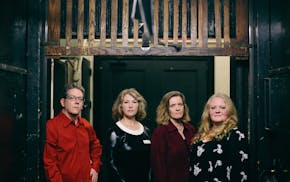Q: I want to see some new bird faces! What are the earliest birds to come back in the spring?
A: One of the first birds to fly back from its winter home is one not often seen in the metro area, the horned lark. You could spot them on farm fields and roadways outside of town beginning in early February. Look for other early birds like sandhilll cranes heading for nesting areas starting in early March, the same time frame that red-winged blackbirds stake their claims on wetlands, and common grackles and great blue herons begin appearing around St. Patrick's Day. A sure sign that spring is on its way is the sight of turkey vultures soaring overhead, anytime after the third week in March. If you're thinking of birds with pretty songs, then the arrival of early Eastern meadowlarks in open grasslands, like Lake Elmo Park Reserve and Three Rivers Park District parks, in mid-April will cheer your heart.
Housing for 'dees
Q: I received a bird house for wrens or chickadees, the label says, as a holiday present. When should I put it outside?
A: I'd say right about now, since chickadees are early nesters and are already prospecting for good places to raise a family. It's best to mount such nest boxes on a pole away from tree branches and shrubs, and place a squirrel guard on the pole or post so predators like squirrels and cats can't shinny up to claim an easy meal. Wrens arrive back from migration somewhat later, and if the chickadees are lucky, they'll have fledged their brood before a wren seeks to commandeer the box.
Early bird?
Q: I've been seeing a red-tailed hawk in a local park and flying overhead lately. Isn't this early in the year for this hawk?
A: It's likely that the red-tail you're seeing has been around all winter, since red-tails are what is known as "partial migrants," meaning some are migratory and some aren't. Most of these handsome hawks head for Southern locations to spend the winter, but some remain year-round, no matter how severe the weather.
Hummingbird fever
Q: I want to be ready the minute hummingbirds come back to town. When should I plan to put out my nectar feeder?
A: I like your intentions, and you could hang your nectar feeder outdoors beginning about the third week in April, when the early arrivers start passing through. If you want to track ruby-throated hummingbirds' progress after they cross the Gulf of Mexico this spring, check this website from time to time for frequently updated maps: www.hummingbirdcentral.com. And don't forget the Audubon Society's Hummingbirds at Home site, a citizen science project where you can report hummingbird sightings, to help researchers develop a picture of how climate change is affecting the tiny birds: www.audubon.org/content/hummingbirds-home.
White-headed cardinal
Q: There's a female cardinal with a white head coming to my feeders. This seems so odd and I wonder: What causes it?
A: I'll bet this bird is an arresting sight, and while not common, people report cardinals with white heads or white patches on their bodies from time to time. There's some disagreement about whether this is caused by a gene mutation or damage to a bird's pigment cells during development. The condition is referred to as leucism and is different from albinism. I checked the Cornell Lab of Ornithology's Project FeederWatch site, where there are quite a few reports and photos of white-headed cardinals, and, like yours, many of them are females.
More harm than help
Q: I hope you can help me with a problem with my neighbor: He insists on spreading dog and cat food in his driveway. He shovels this food out every day and it attracts crowds of crows and all sorts of critters like foxes, squirrels, rats and raccoons. He says he's doing it to help birds, but since he's been doing this (for years) we haven't seen any cardinals or other songbirds. I've talked to my city about it but there's been no help so far. What else can we do?
A: This is an unhealthy situation and I find it surprising that your city allows it to continue. Some municipalities ban feeding animals on the ground specifically to prevent rat infestations, and you've noted that another neighbor has videotapes of rats among the animals feeding on the kibble. I'd suggest that you contact the city again, as well as your city council representative, to show them the videos and request the city to intervene.
The cat and dog kibble isn't really appealing to songbirds, and the presence of so many other large birds and mammals is discouraging them from visiting. I'm hoping your city will assign a health inspector to this problem. In the meantime, might you and other neighbors invest in a good bird feeder and some seed and donate these to your neighbor, tactfully suggesting that this will be better for the birds?
Seed ball avoidance
Q: We have had many birds at our feeders, including finches, cardinals, sparrows and chickadees. But we recently hung a seed ball near a window and only the chickadees will feed on it. Is there a reason other birds avoid it?
A: Chickadees are intrepid little birds and are almost always the first to try a new food source, so it's not surprising that they tried the seed ball, liked it and keep coming back. Other birds could be unwilling to come close to your house to feed — they may see movement inside the house and decide not to chance it. While they visit your other feeders the chickadees will be happy to have a new feeder all to themselves.
St. Paul resident Val Cunningham, who volunteers with the St. Paul Audubon Society and writes about nature for local, regional and national newspapers and magazines, can be reached at valwrites@comcast.net.

The 5 best things our food writers ate this week

A Minnesota field guide to snow shovels: Which one's best?

Summer Camp Guide: Find your best ones here

Lowertown St. Paul losing another restaurant as Dark Horse announces closing





